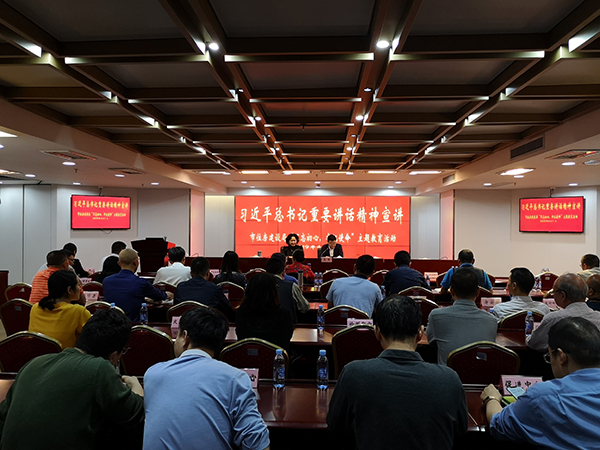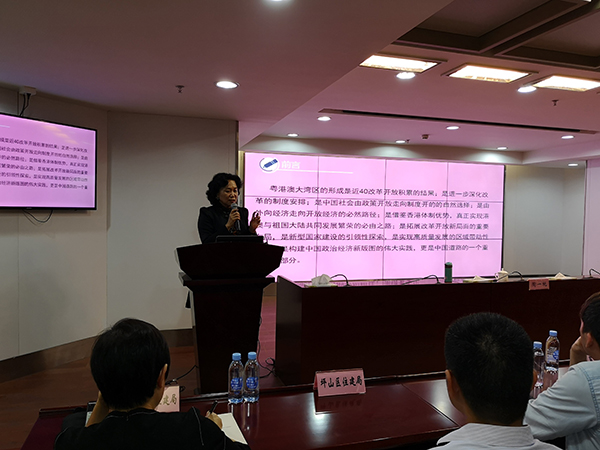On March 28, Prof. Tao Yitao visited Shenzhen Housing and Urban-Rural Development Bureau (SHURDB) at its invitation and delivered a thematic lecture titled “The Theoretical and Practical Significance of the Development Plan for Guangdong-Hong Kong-Macao Greater Bay Area” for a group of 130 persons, including party members from the Housing and Construction Departments and Bureaus at district levels and people's representatives in Shenzhen. Prof. Tao Yitao is a member of the Publicity Office for The Outline Development Plan for Guangdong-Hong Kong-Macao Greater Bay Area in Guangdong Province, Director of the China Center for Special Economic Zone Research (CCSEZR) of Shenzhen University (SZU), dean of the Belt and Road Research Institute of Shenzhen University and also dean of the Belt and Road Research Institute (Shenzhen) for International Cooperation and Development (BRRIICD). Gao Quan, Deputy Director of SHURDB, presides over the event.

Photo 1 A scene of the lecture
Prof. Tao said that if the Development Plan for Guangdong-Hong Kong-Macao Greater Bay Area is a guideline document for current and future cooperation of the Greater Bay Area, then the Greater Bay Area will be an experimental zone intended to offer reference and experience that can be borrowed for China to deepen reform, further open up on all fronts and explore comprehensive development in the future. She held that the construction of the Greater Bay Area is of the same milestone significance in the history of China's reform and opening-up as the establishment of the special economic zones (SEZs) 40 years ago. Building the Greater Bay area is to achieve regional integration, the key of which lies in the establishment of a system to underpin regional integration. Fundamentally, we need to establish a rule of law-based and open socialist market economy system that both reflects the characteristics of China and conforms to international practices.

Photo 2 Prof. Tao Yitao
Prof. Tao Yitao delved into the theoretical significance of the formation of the Bay Areas in China and other countries and compared their formation mechanisms from the following eight aspects: Economic aggregates of the Greater Bay Area, institutional characteristics of the Greater Bay Area, contribution of urban agglomeration to economy, Chinese mode of the Bay Area, five major features of the Greater Bay Area, theoretical significance of the Bay Area economy, comparison between the formation mechanisms of Bay Areas in China and other countries, and mission of the Bay Area economic belt in China. She stressed that the Bay Area economy is by no means a simple concept of regional economics for China, but a growth pole that suffices to further China's social reform and opening-up. Through exploration and development, the Bay Area economy will lead further reform, and promote the move from policy opening to institutional opening, and the transition from an export-led economy to an open economy.
She also stressed that the challenges facing China’s Bay Area and the role it plays have noticeable country-specific characteristics as the historical process and context in which Bay Areas are formed differ for China and other countries. The formation of the Bay Area in China is related to the formation and development of the SEZs. The Bay Area is the result of the “diffusion effect” of the SEZs and will also become the growth pole that produces new “siphon effect”, so to speak, which reflects the unique path of China's social institutional change.

Photo 3 Prof. Tao Yitao compares the formation mechanisms of the Bay Areas in China and other countries
Prof. Tao believed that Shenzhen, as the most dynamic city in the Greater Bay Area, creates a “demonstration effect” for institutional change, a “siphon effect” to attract high-quality resource elements, and a “diffusion effect” to boost the economy of the surrounding areas, and plays the role of an “engine” to drive development of regional economy and a “leader” to motivate innovation. From the perspective of national strategy, truly capitalizing on the geographical advantage of Shenzhen’s adjacency to Hong Kong can further lift institutional and cultural barriers, form consensus, establish mutual trust and provide equal opportunities for the mutual prosperity of Hong Kong and mainland China, making mutual development and prosperity the harvest of China’s reform and opening-up for both areas.
Prof. Tao pointed out that Shenzhen and Hong Kong have a total area of only over 3,000 square kilometers, but the sum of their GDPs reaches 4.08 trillion yuan, equivalent to 1.48 times that of Shanghai, and is the sum of the total GDP of the cities in the Pearl River estuary and Hangzhou Bay, while the total GDP of the cities in the Pearl River estuary is equivalent to 1.51 times that of the cities along the coast of Hangzhou Bay. Hong Kong and Shenzhen have a per capita GDP of 290,000 and 167,400 yuan respectively, obviously topping that of Shanghai, and also lead other cities in the Bay Area economic belt. They are both the irreplaceable satellite cities as high-quality engines in the Greater Bay Area economic belt, and together constitute the unique connected growth poles.
At the end of the lecture, she emphasized that we should resolve the problem of market being more open than society through institutional reform, and should achieve talent internationalization by innovating talent mechanism. In addition, we have to change our mindset as not all change is reform, and we shall by no means return to the planned economy in the name of reform. It is entirely possible for Shenzhen to become an engine with strongest radiation and “diffusion effect” in Guangdong, Hong Kong and Macau Greater Bay Area as “China’s Silicon Valley”, providing a comprehensive innovation support for the fundamental enhancement of China’s competitive edges on the international arena.

Photo 4 Attendees carefully listen to the lecture
The lecture came to a successful conclusion amidst cheering applause. Many attendees said they benefited a lot from the lecture and had a deeper understanding of the development plan of Guangdong, Hong Kong and Macau Greater Bay Area.



